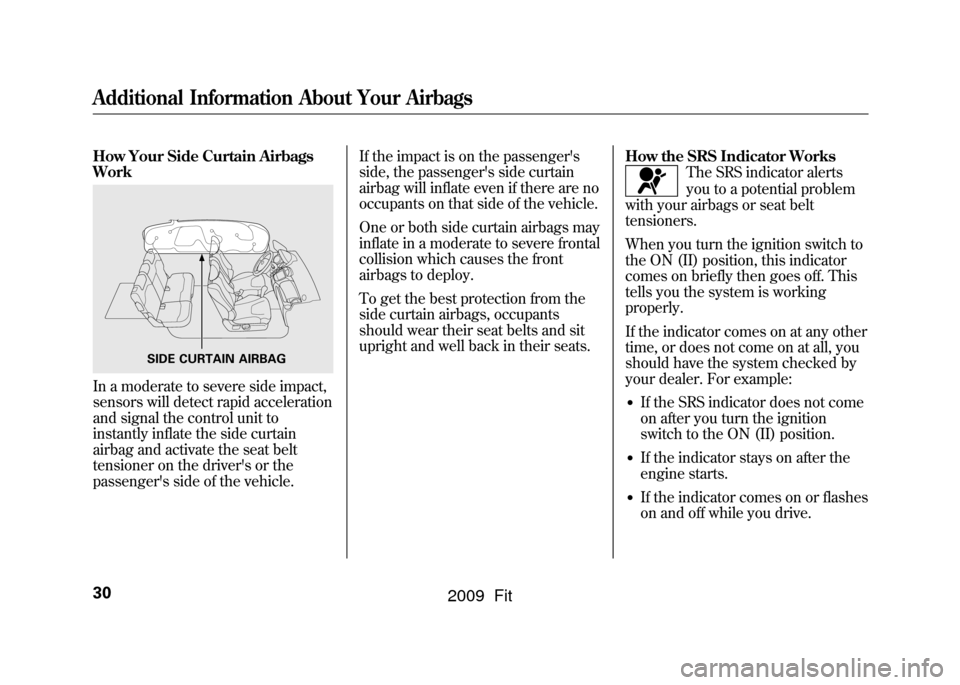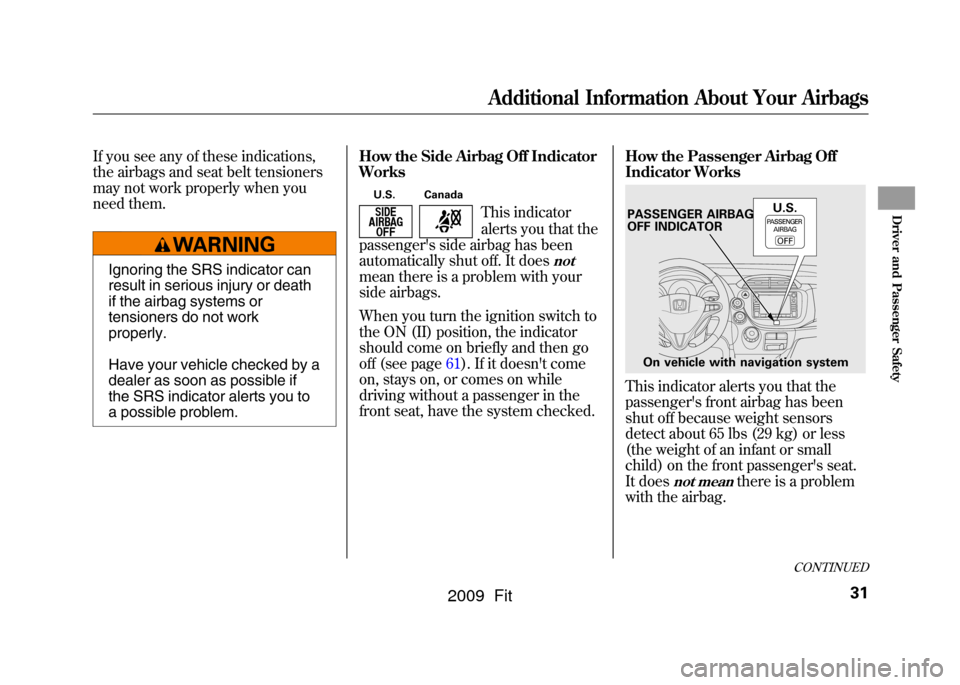2009 HONDA FIT airbag off
[x] Cancel search: airbag offPage 32 of 352

Only one airbag will deploy during a
side impact. If the impact is on the
passenger's side, the passenger's
side airbag will deploy even if there
is no passenger.
To get the best protection from the
side airbags, front seat occupants
should wear their seat belts and sit
upright and well back in their seats.
Side Airbag Cutoff SystemYour vehicle has a side airbag cutoff
system designed primarily to protect
a child riding in the front passenger's
seat.
Although Honda does not encourage
children to ride in front, if the
position sensors detect a child has
leaned into the side airbag's
deployment path, the airbag will shut
off.
The side airbag may also shut off if a
short adult leans sideways, or a
larger adult slouches and leans
sideways into the airbag's
deployment path.
Objects placed on the front
passenger seat can also cause the
side airbag to be shut off.If the side airbag off indicator comes
on (see page31),have the passenger
sit upright. Once the passenger is
out of the airbag's deployment path,
the system will turn the airbag back
on, and the indicator will go out.
There will be some delay between
the moment the passenger moves
into or out of the airbag deployment
path and when the indicator comes
on or goes off.
A front seat passenger should not
use a cushion or other object as a
backrest. It may prevent the cutoff
system from working properly.
Additional Information About Your Airbags
29
Driver and Passenger Safety
2009 Fit
Page 33 of 352

How Your Side Curtain Airbags
WorkIn a moderate to severe side impact,
sensors will detect rapid acceleration
and signal the control unit to
instantly inflate the side curtain
airbag and activate the seat belt
tensioner on the driver's or the
passenger's side of the vehicle.If the impact is on the passenger's
side, the passenger's side curtain
airbag will inflate even if there are no
occupants on that side of the vehicle.
One or both side curtain airbags may
inflate in a moderate to severe frontal
collision which causes the front
airbags to deploy.
To get the best protection from the
side curtain airbags, occupants
should wear their seat belts and sit
upright and well back in their seats.
How the SRS Indicator Works
The SRS indicator alerts
you to a potential problem
with your airbags or seat belt
tensioners.
When you turn the ignition switch to
the ON (II) position, this indicator
comes on briefly then goes off. This
tells you the system is working
properly.
If the indicator comes on at any other
time, or does not come on at all, you
should have the system checked by
your dealer. For example:
●If the SRS indicator does not come
on after you turn the ignition
switch to the ON (II) position.●If the indicator stays on after the
engine starts.●If the indicator comes on or flashes
on and off while you drive.
SIDE CURTAIN AIRBAG
Additional Information About Your Airbags30
2009 Fit
Page 34 of 352

If you see any of these indications,
the airbags and seat belt tensioners
may not work properly when you
need them.
Ignoring the SRS indicator can
result in serious injury or death
if the airbag systems or
tensioners do not work
properly.
Have your vehicle checked by a
dealer as soon as possible if
the SRS indicator alerts you to
a possible problem.How the Side Airbag Off Indicator
Works
U.S. Canada
This indicator
alerts you that the
passenger's side airbag has been
automatically shut off. It does
not
mean there is a problem with your
side airbags.
When you turn the ignition switch to
the ON (II) position, the indicator
should come on briefly and then go
off (see page61).If it doesn't come
on, stays on, or comes on while
driving without a passenger in the
front seat, have the system checked. How the Passenger Airbag Off
Indicator Works
This indicator alerts you that the
passenger's front airbag has been
shut off because weight sensors
detect about 65 lbs (29 kg) or less
(the weight of an infant or small
child) on the front passenger's seat.
It does
not mean
there is a problem
with the airbag.
PASSENGER AIRBAG
OFF INDICATOR
On vehicle with navigation system U.S.
CONTINUED
Additional Information About Your Airbags
31
Driver and Passenger Safety
2009 Fit
Page 35 of 352

Be aware that objects placed on the
front seat can cause the indicator to
come on.
If the weight sensors detect there is
no passenger in the front seat, the
airbag will be off. However, the
passenger airbag off indicator will
not come on.
The passenger airbag off indicator
may come on and off repeatedly if the
total weight on the seat is near the
airbag cutoff threshold.If an adult or teenage passenger is
riding in front, move the seat as far to
the rear as possible, and have the
passenger sit upright and wear the
seat belt properly.
If the indicator comes on with no
front seat passenger and no objects
on the seat, or with an adult riding
there, something may be interfering
with the weight sensors. Look for
and remove:
●Any items under the front
passenger's seat.●Any object hanging on the seat or
in the seat-back pocket.●Any object(s), such as a folded-
down back seat, that are touching
the rear of the seat-back.
If no obstructions are found, have
your vehicle checked by a dealer as
soon as possible. Airbag Service
Your airbag systems are virtually
maintenance free, and there are no
parts you can safely service.
However, you must have your
vehicle serviced if:
●An airbag ever inflates.
Any airbag
that has deployed must be
replaced along with the control
unit and other related parts. Any
seat belt tensioner that activates
must also be replaced.
Do not try to remove or replace
any airbag by yourself. This must
be done by an authorized dealer or
a knowledgeable body shop.
●The SRS indicator alerts you to a
problem.
Take your vehicle to an
authorized dealer as soon as
possible. If you ignore this
indication, your airbags may not
operate properly.
PASSENGER AIRBAG OFF INDICATOR
On vehicle without navigation system U.S. CanadaAdditional Information About Your Airbags32
2009 Fit
Page 36 of 352

●If your vehicle has a moderate tosevere impact.
Even if your airbags
do not inflate, your dealer should
inspect the driver's seat position
sensor, the front passenger's
weight sensors, the front seat belt
tensioners, and all seat belts worn
during a crash to make sure they
are operating properly. Additional Safety Precautions
●Do not attempt to deactivate your
airbags.
Together, airbags and
seat belts provide the best
protection.
●Do not tamper with airbag components or wiring for any
reason.
Tampering could cause
the airbags to deploy, possibly
causing very serious injury.
●Do not expose the front
passenger's seat-back to liquid.
If
water or another liquid soaks into
a seat-back, it can prevent the side
airbag cutoff system from working
properly.
●Do not cover or replace front seat- back covers without consulting
your dealer.
Improperly replacing
or covering front seat-back covers
can prevent your side airbags from
inflating during a side impact.
●Do not remove or modify a front seat without consulting your
dealer.
This could make the
driver's seat position sensor or the
front passenger's weight sensors
ineffective. If it is necessary to
remove or modify a front seat to
accommodate a person with
disabilities, first contact Honda
Automobile Customer Service at
(800) 999-1009.
Additional Information About Your Airbags
33
Driver and Passenger Safety
2009 Fit
Page 38 of 352

All Children Should Sit in a Back
Seat
According to accident statistics,
children of all ages and sizes are
safer when they are restrained in a
back seat.
The National Highway Traffic Safety
Administration and Transport
Canada recommend that all children
aged 12 and under be properly
restrained in a back seat. Some
states have laws restricting where
children may ride.
Children who ride in back are less
likely to be injured by striking
interior vehicle parts during a
collision or hard braking. Also,
children cannot be injured by an
inflating front airbag when they ride
in the back.The Passenger's Front Airbag Can
Pose Serious Risks
Front airbags have been designed to
help protect adults in a moderate to
severe frontal collision. To do this,
the passenger's front airbag is quite
large, and it can inflate with enough
force to cause very serious injuries.
Even though your vehicle has an
advanced front airbag system that
automatically turns the passenger's
front airbag off (see page31),please
follow these guidelines:
Infants
Never put a rear-facing child seat inthe front seat of a vehicle equipped
with a passenger's front airbag.
If the
airbag inflates, it can hit the back of
the child seat with enough force to
kill or very seriously injure an infant.
Small Children
Placing a forward-facing child seat inthe front seat of a vehicle equippedwith a passenger's front airbag can be
hazardous.
If the vehicle seat is too
far forward, or the child's head is
thrown forward during a collision, an
inflating front airbag can strike the
child with enough force to kill or
very seriously injure a small child.
Larger Children
Children who have outgrown childseats are also at risk of being injuredor killed by an inflating passenger's
front airbag.
Whenever possible,
larger children should sit in the back
seat, on a booster seat if needed, and
be properly restrained with a seat
belt (see page49for important
information about protecting larger
children).
CONTINUED
Protecting Children -General Guidelines
35
Driver and Passenger Safety
2009 Fit
Page 44 of 352

Even with advanced front airbags
that automatically turn the
passenger's front airbag off (see page
31),a back seat is the safest place for
a small child.
If it is necessary to put a forward-
facing child seat in the front, move
the vehicle seat as far to the rear as
possible, and be sure the child seat is
firmly secured to the vehicle and the
child is properly strapped in the seat.
Placing a forward-facing child
seat in the front seat can result
in serious injury or death if the
front airbag inflates.
If you must place a forward-
facing child seat in front, move
the vehicle seat as far back as
possible, and properly restrain
the child.Selecting a Child Seat
When buying a child seat, you need
to choose either a conventional child
seat, or one designed for use with
the lower anchors and tethers for
children (LATCH) system.
Conventional child seats must be
secured to a vehicle with a seat belt,
whereas LATCH-compatible seats
are secured by attaching the seat to
hardware built into the two outer
seating positions in the back seat.
Since LATCH-compatible child seats
are easier to install and reduce the
possibility of improper installation,
we recommend selecting this style.
In seating positions and vehicles not
equipped with LATCH, a LATCH-
compatible child seat can be installed
using a seat belt.
Whatever type of seat you choose, to
provide proper protection, a child
seat should meet three
requirements:
1.
The child seat should meet U.S. or
Canadian Motor Vehicle Safety
Standard 213.
Look for FMVSS
213 or CMVSS 213 on the box.
2.
The child seat should be of the proper type and size to fit the child.Rear-facing for infants, forward-
facing for small children.
3.The child seat should fit the vehicle seating position (or positions)
where it will be used.
Before purchasing a conventional
child seat, or using a previously
purchased one, we recommend that
you test the seat in the specific
vehicle seating position or positions
where the seat will be used.
Protecting Infants and Small Children, Selecting a Child Seat
41
Driver and Passenger Safety
2009 Fit
Page 62 of 352

ꭧ: If equippedSECURITY SYSTEM INDICATOR
ꭧ(P. 66, 193)
WASHER LEVEL
INDICATOR
ꭧ(P.65)
MALFUNCTION
INDICATOR LAMP (P. 304)
CHARGING SYSTEM
INDICATOR (P. 60,303)
LOW OIL PRESSURE
INDICATOR (P. 60,303) IMMOBILIZER SYSTEM
INDICATOR (P.
66)
FOG LIGHT INDICATOR
ꭧ(P.
64) LIGHTS ON INDICATOR (P.
64)
SUPPLEMENTAL RESTRAINT
SYSTEM INDICATOR (P. 30,61)
MAINTENANCE MINDER
INDICATOR (P.
66) CRUISE MAIN INDICATOR
ꭧ(P.
65)
CRUISE CONTROL
INDICATOR
ꭧ(P. 65)
LOW TEMPERATURE INDICATOR (P. 63)
ELECTRIC POWER
STEERING (EPS)
INDICATOR (P.
62)
HIGH BEAM INDICATOR (P.
65)
LOW FUEL INDICATOR
(P.62)
TPMS INDICATOR
ꭧ(P.
64)
SEAT BELT REMINDER
INDICATOR (P. 60)
PARKING BRAKE AND
BRAKE SYSTEM INDICATOR
(P. 60, 305)
DAYTIME RUNNING LIGHTS INDICATOR (P.
65)
HIGH TEMPERATURE
INDICATOR (P. 63)
VEHICLE STABILITY ASSIST (VSA)
SYSTEM INDICATOR
ꭧ(P.
67)
VSA OFF INDICATORꭧ
(P. 67) SIDE AIRBAG OFF INDICATOR (P.
31,61)
LOW TIRE PRESSURE INDICATOR
ꭧ(P. 64)
ANTI-LOCK BRAKE SYSTEM
INDICATOR (P. 62)
DOOR AND TAILGATE OPEN
INDICATOR (P.
62)
Instrument Panel
59
Instruments and Controls
2009 Fit